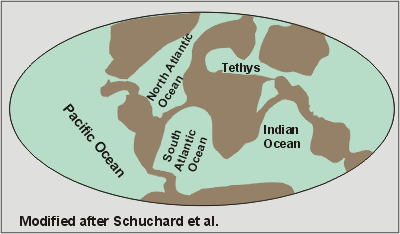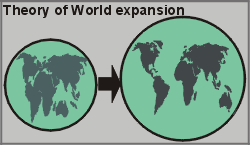Theories
The old theory of land bridges connecting continents.
Image Credit: Griem (2007), modified after Schuchardt, K. (1889): Ueber das Wesen der Ozeane nebst einigen Bemerkungen über Epithelmetaplasie.- Leipzig
The theory of world expansion
Image Credit: Griem (2007), modified after Schuchardt, K. (1889): Ueber das Wesen der Ozeane nebst einigen Bemerkungen über Epithelmetaplasie.- Leipzig.
Land bridges versus plate tectonics
The 19th-century geologist J.D. Dana proposed the continent accretion theory in which the continents had always been stationary, and new material had accreted around a central nucleus. The "continental assimilation" hypothesis stated that oceans accumulated the denser elements, then subsided to form basins. In the late 19th century, George Darwin proposed that the moon had gravitationally been extracted from the Pacific Ocean, with the earth eventually redistributing into oceanic and continental crusts (www.encyclopedia.com/doc/1E1-continent.html).
Fossils and lithologies on several continents now separated by wide oceans show striking similarities. Glossopteris, a seed fern, occurs in India, South Africa, Australia and South America. Permian reptiles, such as Mesosaurus, lived on both sides of the Atlantic. This distribution of fossils lead scientists, among others E. Suess, to suggest that land bridges had connected the continents, allowing long-distance dispersal of fauna and flora. These land bridges later had subsided below sea level.
During the early 20th century, important contributions from geologists such as F.B. Taylor in the U.S.A., A. Wegener in Germany, B. Choubert in France, A. Holmes in Britain and L. du Toit in South Africa gave increasing credit to the concecpt of Gondwana as a former southern-hemisphere supercontinent and to the related concept of mobile continents, or "continental drift". but only oceanographic research following the Second Wolrd War allowed to recognize that the creation of new oceanic lithosphere along divergent plate boundaries had led to the breakup of Gondwana into the current continents (www.searchanddiscovery.net/documents/97019/index.htm).



